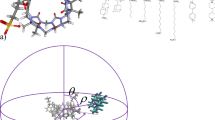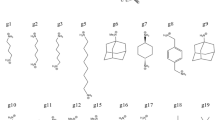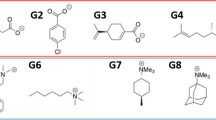Abstract
Host–guest binding is a challenging problem in computer simulation. The prediction of binding affinities between hosts and guests is an important part of the statistical assessment of the modeling of proteins and ligands (SAMPL) challenges. In this work, the volume-based variant of well-tempered metadynamics is employed to calculate the binding affinities of the host–guest systems in the SAMPL6 challenge. By biasing the spherical coordinates describing the relative position of the host and the guest, the initial-configuration-induced bias vanishes and all possible binding poses are explored. The agreement between the predictions and the experimental results and the observation of new binding poses indicate that the volume-based technique serves as a nice candidate for the calculation of binding free energies and the search of the binding poses.




Similar content being viewed by others
References
Wang X, Xingzhao T, Boming D, John ZHZ, Sun Z (2019) BAR-based optimum adaptive steered MD for configurational sampling. J Comput Chem 40(12):1270–1289
Cooper A, Johnson CM, Lakey JH, Nöllmann M (2001) Heat does not come in different colours: entropy–enthalpy compensation, free energy windows, quantum confinement, pressure perturbation calorimetry, solvation and the multiple causes of heat capacity effects in biomolecular interactions. Biophys Chem 93(2–3):215–230
Makhatadze GI, Privalov PL (1994) Hydration effects in protein unfolding. Biophys Chem 51(2–3):291–309
Chang C-E, Gilson MK (2004) Free energy, entropy, and induced fit in host− guest recognition: calculations with the second-generation mining minima algorithm. J Am Chem Soc 126(40):13156–13164
Chodera JD, Mobley DL (2013) Entropy-enthalpy compensation: role and ramifications in biomolecular ligand recognition and design. Ann Rev Biopys 42:121–142
Reynolds CH, Holloway MK (2011) Thermodynamics of ligand binding and efficiency. ACS Med Chem Lett 2(6):433–437
Böhm HJ, Klebe G (1996) What can we learn from molecular recognition in protein–ligand complexes for the design of new drugs? Angew Chem Int Ed 35(22):2588–2614
Wang X, Deng B, Sun Z (2019) Thermodynamics of helix formation in small peptides of varying length in vacuo, in implicit solvent, and in explicit solvent. J Mol Model 25(1):3
And SET, Smithrud DB (2002) Carboxylates stacked over aromatic rings promote salt bridge formation in water. J Am Chem Soc 124(3):442
Makin OS, Atkins E, Sikorski P, Johansson J, Serpell LC (2005) Molecular basis for amyloid fibril formation and stability. Proc Natl Acad Sci USA 102(2):315–320
Rani P, Biswas P (2015) Diffusion of hydration water around intrinsically disordered proteins. J Phys Chem B 119(42):13262–13270
GlH Z, Best RB, Mittal J (2015) Sequence-and temperature-dependent properties of unfolded and disordered proteins from atomistic simulations. J Phys Chem B 119(46):14622–14630
Brooks BR, Brooks CL III, Mackerell AD Jr, Nilsson L, Petrella RJ, Roux B, Won Y, Archontis G, Bartels C, Boresch S (2009) CHARMM: the biomolecular simulation program. J Comput Chem 30(10):1545–1614
Phillips JC, Braun R, Wang W, Gumbart J, Tajkhorshid E, Villa E, Chipot C, Skeel RD, Kale L, Schulten K (2005) Scalable molecular dynamics with NAMD. J Comput Chem 26(16):1781–1802
Plimpton S (1995) Fast parallel algorithms for short-range molecular dynamics. J Comput Phys 117(1):1–19
Best RB, de Sancho D, Mittal J (2012) Residue-specific α-helix propensities from molecular simulation. Biophys J 102(6):1462–1467
Makowski M, Liwo A, Scheraga HA (2017) Simple physics-based analytical formulas for the potentials of mean force of the interaction of amino acid side chains in water. VII. Charged–hydrophobic/polar and polar–hydrophobic/polar side chains. J Phys Chem B 121(2):379–390
Tobias DJ, Brooks CL (1991) Thermodynamics and mechanism of alpha helix initiation in alanine and valine peptides. Biochemistry 30(24):6059–6070
Hudson PS, Woodcock HL, Boresch S (2015) Use of nonequilibrium work methods to compute free energy differences between molecular mechanical and quantum mechanical representations of molecular systems. J Phys Chem Lett 6(23):4850–4856
Martínezveracoechea FJ, Escobedo FA (2008) Variance minimization of free energy estimates from optimized expanded ensembles. J Phys Chem B 112(27):8120–8128
Sun Z, Yan YN, Yang M, Zhang JZ (2017) Interaction entropy for protein-protein binding. J Chem Phys 146(12):124124
Wang X, Sun Z (2018) A theoretical interpretation of variance-based convergence citeria in perturbation-based theories. arXiv preprint arXiv:1803.03123
Wang X, He Q, Sun Z (2019) BAR-based multi-dimensional nonequilibrium pulling for indirect construction of a qm/mm free energy landscape. Phys Chem Chem Phys 21(12):6672–6688
Sun Z (2019) BAR-based multi-dimensional nonequilibrium pulling for indirect construction of QM/MM free energy landscapes: from semi-empirical to ab initio. Phys Chem Chem Phys 21(39):21942–21959
Kästner J (2011) Umbrella sampling. Wiley Interdis Rev Comput Mol Sci 1(6):932–942
Sun Z, Wang X, Zhang JZH (2017) Protonation-dependent base flipping in the catalytic triad of a small RNA. Chem Phys Lett 684:239–244
Sun Z, Wang X, Zhang JZH, He Q (2019) Sulfur-substitution-induced base flipping in the DNA duplex. Phys Chem Chem Phys 21:14923–14940
Wang X, Tu X, Zhang JZH, Sun Z (2018) BAR-based optimum adaptive sampling regime for variance minimization in alchemical transformation: the nonequilibrium stratification. Phys Chem Chem Phys 20(3):2009–2021
Shirts MR, Pande VS (2005) Solvation free energies of amino acid side chain analogs for common molecular mechanics water models. J Chem Phys 122(13):134508
Hummer G, Pratt LR, Garcia AE (1995) Hydration free energy of water. J Phys Chem 99(38):14188–14194
Sun Z, Wang X, Song J (2017) Extensive assessment of various computational methods for Aspartate’s pKa shift. J Chem Inf Model 57(7):1621–1639
Sun ZX, Wang XH, Zhang JZH (2017) BAR-based optimum adaptive sampling regime for variance minimization in alchemical transformation. Phys Chem Chem Phys 19(23):15005–15020
Gallicchio E, Levy RM (2011) Advances in all atom sampling methods for modeling protein-ligand binding affinities. Curr Opin Struct Biol 21(2):161–166
Chodera JD, Mobley DL, Shirts MR, Dixon RW, Branson K, Pande VS (2011) Alchemical free energy methods for drug discovery: progress and challenges. Curr Opin Struct Biol 21(2):150–160
Parenti MD, Rastelli G (2012) Advances and applications of binding affinity prediction methods in drug discovery. Biotechnol Adv 30(1):244–250
Boyce SE, Mobley DL, Rocklin GJ, Graves AP, Dill KA, Shoichet BK (2009) Predicting ligand binding affinity with alchemical free energy methods in a polar model binding site. J Mol Biol 394(4):747–763
Huang N, Kalyanaraman C, Bernacki K, Jacobson MP (2006) Molecular mechanics methods for predicting protein–ligand binding. Phys Chem Chem Phys 8(44):5166–5177
Qiu L, Yan Y, Sun Z, Song J, Zhang JZ (2018) Interaction entropy for computational alanine scanning in protein–protein binding. Wiley Interdis Rev Comput Mol Sci 8(2):e1342
Dewar MJS, Thiel W (1977) Ground states of molecules. 38. The MNDO method. Approximations and parameters. J Am Chem Soc 99(15):4899–4907
Dewar MJS, Zoebisch EG, Healy EF, Stewart JJP (1985) Development and use of quantum mechanical molecular models. 76. AM1: a new general purpose quantum mechanical molecular model. J Am Chem Soc 107(13):3902–3909
Roothaan CCJ (1951) New developments in molecular orbital theory. Rev Mod Phys 23(23):69–89
Pople JA, Nesbet RK (1954) Self-consistent orbitals for radicals. J Chem Phys 22(3):571–572
Mcweeny R, Diercksen G (1968) Self‐consistent perturbation theory. II. Extension to open shells. J Chem Phys 49(11):4852–4856
Pérez A, Marchán I, Svozil D, Sponer J, Cheatham TE III, Laughton CA, Orozco M (2007) Refinement of the AMBER force field for nucleic acids: improving the description of α/γ conformers. Biophys J 92(11):3817–3829
Hornak V, Abel R, Okur A, Strockbine B, Roitberg A, Simmerling C (2006) Comparison of multiple Amber force fields and development of improved protein backbone parameters. Proteins 65(3):712–725
Maier JA, Martinez C, Kasavajhala K, Wickstrom L, Hauser KE, Simmerling C (2015) ff14SB: Improving the accuracy of protein side chain and backbone parameters from ff99SB. J Chem Theory Comput 11(8):3696–3713
Mahoney MW, Jorgensen WL (2000) A five-site model for liquid water and the reproduction of the density anomaly by rigid. J Chem Phys 112(20):8910–8922
Best RB, Buchete N-V, Hummer G (2008) Are current molecular dynamics force fields too helical? Biophys J 95(1):L07–L09
Allen WJ, Balius TE, Mukherjee S, Brozell SR, Moustakas DT, Lang PT, Case DA, Kuntz ID, Rizzo RC (2015) DOCK 6: Impact of new features and current docking performance. J Comput Chem 36(15):1132–1156
Kapetanovic I (2008) Computer-aided drug discovery and development (CADDD): in silico-chemico-biological approach. Chem Biol Interact 171(2):165–176
Cozzini P, Kellogg GE, Spyrakis F, Abraham DJ, Costantino G, Emerson A, Fanelli F, Gohlke H, Kuhn LA, Morris GM (2008) Target flexibility: an emerging consideration in drug discovery and design. J Med Chem 51(20):6237–6255
Halperin I, Ma B, Wolfson H, Nussinov R (2002) Principles of docking: an overview of search algorithms and a guide to scoring functions. Proteins 47(4):409–443
Shoichet BK, Leach AR, Kuntz ID (1999) Ligand solvation in molecular docking. Proteins 34(1):4
Sotriffer CA, Sanschagrin P, Matter H, Klebe G (2008) SFCscore: scoring functions for affinity prediction of protein–ligand complexes. Proteins 73(2):395–419
Krammer A, Kirchhoff PD, Jiang X, Venkatachalam C, Waldman M (2005) LigScore: a novel scoring function for predicting binding affinities. J Mol Gr Modell 23(5):395–407
Clark RD, Strizhev A, Leonard JM, Blake JF, Matthew JB (2002) Consensus scoring for ligand/protein interactions. J Mol Gr Modell 20(4):281–295
Warren GL, Andrews CW, Capelli A-M, Clarke B, LaLonde J, Lambert MH, Lindvall M, Nevins N, Semus SF, Senger S (2006) A critical assessment of docking programs and scoring functions. J Med Chem 49(20):5912–5931
Swope WC (1982) A computer simulation method for the calculation of equilibrium constants for the formation of physical clusters of molecules: application to small water clusters. J Chem Phys 76(1):637
Pham TT, Shirts MR (2011) Identifying low variance pathways for free energy calculations of molecular transformations in solution phase. J Chem Phys 135(3):034114
Procacci P, Chelli R (2017) Statistical mechanics of ligand-receptor noncovalent association, revisited: binding site and standard state volumes in modern alchemical theories. J Chem Theory Comput 13(5):1924–1933
Wang X, Sun Z (2019) Understanding PIM-1 kinase inhibitor interactions with free energy simulation. Phys Chem Chem Phys 21:7544–7558
Sun Z, Wang X, Zhao Q, Zhu T (2019) Understanding aldose reductase-inhibitors interactions with free energy simulation. J Mol Gr Modell 91:10–21
Sun Z, Wang X, Zhang JZ (2019) Determination of binding affinities of 3-hydroxy-3-methylglutaryl coenzyme A reductase inhibitors from free energy calculation. Chem Phys Lett 723:1–10
Sun Z, Wang X, Zhang JZ (2020) Theoretical understanding of the thermodynamics and interactions in transcriptional regulator TtgR-ligand binding. Phys Chem Chem Phys. 10.26434/chemrxiv.8866250.
Moraca F, Amato J, Ortuso F, Artese A, Pagano B, Novellino E, Alcaro S, Parrinello M, Limongelli V (2017) Ligand binding to telomeric G-quadruplex DNA investigated by funnel-metadynamics simulations. Proc Natl Acad Sci USA 114(11):E2136
Valsson O, Tiwary P, Parrinello M (2016) Enhancing important fluctuations: rare events and metadynamics from a conceptual viewpoint. Annu Rev Phys Chem 67(1):159
Tiwary P, Limongelli V, Salvalaglio M, Parrinello M (2015) Kinetics of protein-ligand unbinding: predicting pathways, rates, and rate-limiting steps. Proc Natl Acad Sci USA 112(5):386–391
Mobley DL, Wymer KL, Lim NM, Guthrie JP (2014) Blind prediction of solvation free energies from the SAMPL4 challenge. J Comput Aided Mol Des 28(3):135–150
Monroe JI, Shirts MR (2014) Converging free energies of binding in cucurbit[7]uril and octa-acid host–guest systems from SAMPL4 using expanded ensemble simulations. J Comput Aided Mol Des 28(4):401–415
Song LF, Bansal N, Zheng Z, Merz KM (2018) Detailed potential of mean force studies on host–guest systems from the SAMPL6 challenge. J Comput Aided Mol Des 32(10):1013–1026
Rizzi A, Murkli S, McNeill JN, Yao W, Sullivan M, Gilson MK, Chiu MW, Isaacs L, Gibb BC, Mobley DL (2018) Overview of the SAMPL6 host–guest binding affinity prediction challenge. J Comput Aided Mol Des 32(10):937–963
Procacci P, Guarrasi M, Guarnieri G (2018) SAMPL6 host–guest blind predictions using a non equilibrium alchemical approach. J Comput Aided Mol Des 32(10):965–982
Nishikawa N, Han K, Wu X, Tofoleanu F, Brooks BR (2018) Comparison of the umbrella sampling and the double decoupling method in binding free energy predictions for SAMPL6 octa-acid host–guest challenges. J Comput Aided Mol Des 32(10):1075–1086
Caldararu O, Olsson MA, Ignjatović MM, Wang M, Ryde U (2018) Binding free energies in the SAMPL6 octa-acid host–guest challenge calculated with MM and QM methods. J Comput Aided Mol Des 32(10):1027–1046
Eken Y, Patel P, Díaz T, Jones MR, Wilson AK (2018) SAMPL6 host–guest challenge: binding free energies via a multistep approach. J Comput Aided Mol Des 32(10):1097–1115
Capelli R, Carloni P, Parrinello M (2019) Exhaustive search of ligand binding pathways via volume-based metadynamics. J Phys Chem Lett 10(12):3495–3499
Gibb CLD, Gibb BC (2004) Well-defined, organic nanoenvironments in water: the hydrophobic effect drives a capsular assembly. J Am Chem Soc 126(37):11408–11409
Haiying G, Benjamin CJ, Gibb BC (2011) Nonmonotonic assembly of a deep-cavity cavitand. J Am Chem Soc 133(13):4770–4773
Murkli S, Mcneill JN, Isaacs L (2019) Cucurbit[8]urilguest complexes: blinded dataset for the SAMPL6 challenge. Supramol Chem 31:150–158
Jakalian A, Jack DB, Bayly CI (2002) Fast, efficient generation of high-quality atomic charges. AM1-BCC model: II. Parameterization and validation. J Comput Chem 23(16):1623–1641
Wang J, Wolf RM, Caldwell JW, Kollman PA, Case DA (2004) Development and testing of a general amber force field. J Comput Chem 25:1157–1173
Jorgensen WL, Chandrasekhar J, Madura JD, Impey RW, Klein ML (1983) Comparison of simple potential functions for simulating liquid water. J Chem Phys 79(2):926–935
Price DJ, Brooks CL III (2004) A modified TIP3P water potential for simulation with Ewald summation. J Chem Phys 121(20):10096–10103
Joung IS, Cheatham TE III (2008) Determination of alkali and halide monovalent ion parameters for use in explicitly solvated biomolecular simulations. J Phys Chem B 112(30):9020–9041
Joung IS, Cheatham TE (2009) Molecular dynamics simulations of the dynamic and energetic properties of alkali and halide ions using water-model-specific ion parameters. J Phys Chem B 113(40):13279–13290
Barducci A, Bonomi M, Parrinello M (2011) Metadynamics. Wiley Interdis Rev Comput Mol Sci 1(5):826–843
Barducci A, Bussi G, Parrinello M (2008) Well-tempered metadynamics: a smoothly converging and tunable free-energy method. Phys Rev Lett 100(2):020603
Tiwary P, Parrinello M (2015) A time-independent free energy estimator for metadynamics. J Phys Chem B 119(3):736–742
Sabri DD, Roitberg AE (2013) Optimization of Umbrella sampling replica exchange molecular dynamics by replica positioning. J Chem Theory Comput 9(9):4692–4699
Park S, Kim T, Im W (2012) Transmembrane helix assembly by window exchange umbrella sampling. Phys Rev Lett 108(10):207–212
Abraham MJ, Murtola T, Schulz R, Páll S, Smith JC, Hess B, Lindahl E (2015) GROMACS: high performance molecular simulations through multi-level parallelism from laptops to supercomputers. SoftwareX 1:19–25
Tribello GA, Bonomi M, Branduardi D, Camilloni C, Bussi G (2014) PLUMED 2: new feathers for an old bird. Comput Phys Commun 185(2):604–613
Giovanni B, Davide D, Michele P (2007) Canonical sampling through velocity rescaling. J Chem Phys 126(1):2384
Nosé S, Klein ML (1983) Constant pressure molecular dynamics for molecular systems. Mol Phys 50(5):1055–1076
Parrinello M, Rahman A (1981) Polymorphic transitions in single crystals: a new molecular dynamics method. J Appl Phys 52(12):7182–7190
York DM, Darden TA, Pedersen LG (1993) The effect of long-range electrostatic interactions in simulations of macromolecular crystals: a comparison of the ewald and truncated list methods. J Chem Phys 99(10):8345–8348
Tuckerman ME, Berne BJ, Martyna GJ (1991) Molecular dynamics algorithm for multiple time scales: systems with long range forces. J Chem Phys 94(10):6811–6815
Acknowledgements
This work was supported China Scholarship Council. Computer access to the CLAIX cluster of RWTH Aachen University and clusters of Forschungszentrum Juelich is gratefully acknowledged. We are grateful for many valuable and insightful comments from the anonymous reviewers.
Author information
Authors and Affiliations
Corresponding author
Ethics declarations
Conflict of interest
There are no conflicts of interest to declare.
Additional information
Publisher's Note
Springer Nature remains neutral with regard to jurisdictional claims in published maps and institutional affiliations.
Electronic supplementary material
Below is the link to the electronic supplementary material.
Rights and permissions
About this article
Cite this article
Sun, Z., He, Q., Li, X. et al. SAMPL6 host–guest binding affinities and binding poses from spherical-coordinates-biased simulations. J Comput Aided Mol Des 34, 589–600 (2020). https://doi.org/10.1007/s10822-020-00294-1
Received:
Accepted:
Published:
Issue Date:
DOI: https://doi.org/10.1007/s10822-020-00294-1




